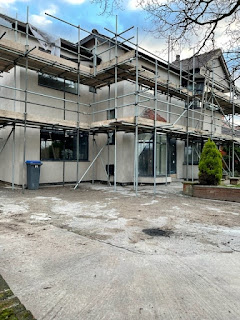It is funny how something small
can trigger a train of thought. I read an article last week that reported on
the acute shortage we have of scaffolders in the UK. Given that we seem to have
constant waves of shortages of everything from lorry drivers, toilet rolls,
fresh fruit and vegetables and, it seems, honest politicians, perhaps I shouldn’t
have been surprised. The story did, nevertheless,
stir my little grey cells. Until the middle of last week, we have lived with a
dirty sponge poking out of the end of a scaffolding pole, which was located
directly in front of our front door. It was not our sponge, nor even our
scaffolding pole. It was, however, our front door, which is actually located on the side of our house.
In early 2020 our next door
neighbours decided to sell their house. They had lived in it for some 34 years
and, to be fair, they hadn’t done much in the past 20 years in terms of
modernisation, painting and decorating and so on. Despite being in their seventies,
they started to prepare their house for sale with great gusto. Which, at first, was wonderful to witness. It was the time of the early lockdowns. We didn’t
do ‘working afternoons with wine’ in our garden; there was, after all
only J and me in the house/extended office environment. We did however like to
sit outside in the sunshine, but often had to give up as the sawing, grinding, cursing
and hammering from next door made it impossible to sit outside for too long.
Like our Prime Minister, we could usually endure it for 25 minutes or so, before
retiring inside away from the noise of people working. The building work went
on for much of 2020. Fast forward to February 2021 and the house is sold, and
the new owner, immediately starts work on stripping out the whole house right
back to the bare brick work.
But actually, none of the above
is what I wanted to write about – the original story sparked a train of thought
about a different kind of scaffolding. Students of psychology and/or education will
know of the concept. It is most often associated with the Russian psychologist Lev
Vygotsky, although he never actually used the term in his writing. Scaffolding
as a concept can be traced back further to the likes of Foucault, Derrida,
Geertz and White; that latter possibly the most well-known for his work on how
scaffolding can be used in therapy and learning environments. An important element
of this scaffolding is what has been described as the ‘zone of proximal
development’. This zone bridges the gap between what is known and what is
possible to know. It is within this gap that learning occurs.
In my work with my long time
collaborator and writer, Professor Sue McAndrew, we developed this notion further
to suggest that learning and understanding best occurs at the gap between
knowledge, and knowing, that is ‘not knowing’. Scaffolding can be useful
in helping others move from being dependent on others for understanding and explanation
to independence in thought, understanding and action. Whether it is in the therapeutic
or educational encounter, scaffolding requires the presence of someone with knowledge
and skills beyond that of the patient or learner (the knowledgeable other). It is
the therapist or teacher that guides the patient or learner on a journey of personal
discovery. This journey helps with the acquisition of the skills and learning required
to resolve mental health challenges and/or problems that might inhibit normal growth
and development.
Thinking about all of this did
make me wonder whether scaffolding might also be a useful way of conceptualising
the Health and Care Bill, currently making its way through the House of Lords. Last
week I was fortunate to be part of a conversation with Baroness Glenys Thornton.
She is a formidable woman, who has been a long time campaigner against inequalities
of all kinds. She has, since the age of 16, being a member of the Co-operative
Party. She was also a former Labour Minister for Health and is currently shadow
spokesperson for health. Our conversation started with a discussion on the
process of the Bill’s passage through The Lords, and then what some of the
issues were that had been raised by some 302 amendments submitted since the Bill
was in the House of Commons. It was an insightful discussion.
My take home message was that the Bill is reminiscent of my neighbour’s scaffolding. In itself, it isn’t a home or even a house. The scaffolding is there to enable a transformation to occur. Once that transformation has happened, the scaffolding should be removed. Those amendments mean that we haven’t got the scaffolding in the right place just yet. There are too many dirty sponges to be seen. We should not end up with an Act of Parliament that constrains ambition, or transformation. The Act should be there to facilitate the achievement of its ambitions. Top of which are to more effectively deal with health inequalities, deliver place-based services, make best use of new technologies and reduce the need for acute hospital services.
Sadly, social care reform doesn’t feature much at all in the Bill, but that is something for another blog. However, talking with Glenys last week, I came away with a much greater sense of confidence that these issues were at the forefront of people’s minds, across all sides of the House of Lords. I hope in the fullness of time The Lords will be able to provide the Government with a well-thought through and evidence-based second opinion.

No comments:
Post a Comment